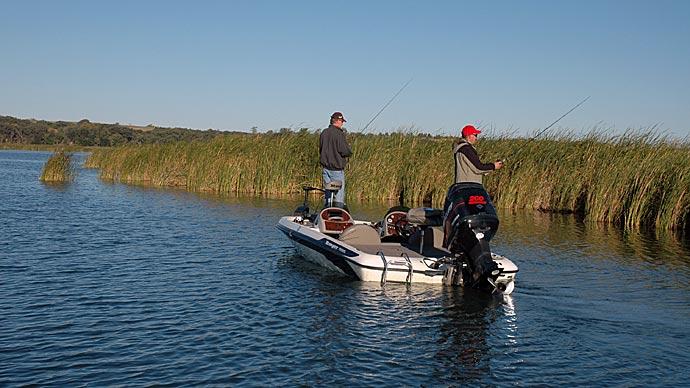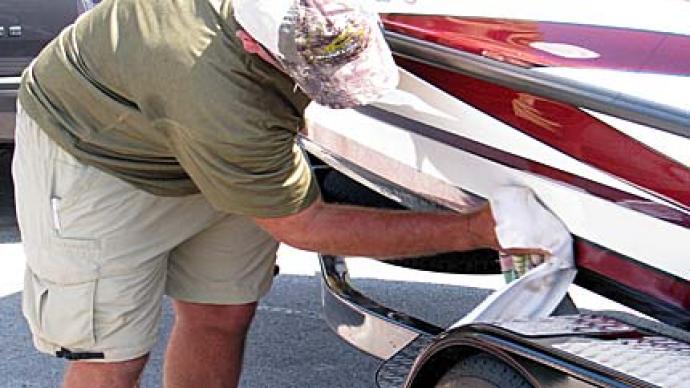| Trailering Checklist |
|
BOATU.S. ANGLER offers the following trailer checklist for those hauling bass boats and other vessels to water. Frame Brakes Rollers and Pads Hubs and Bearings Tires Lights Other Ensure the safety chain is crisscrossed and secured between the car and trailer. Leave enough slack to allow for proper turning, but not so much that the chain drags on the ground. The gear inside the trailer should be stowed so that it doesn't shift or get blown out of the boat onto the highway. Dispose of any trash. Make sure the car and trailer are level. A car with too much or too little weight at the hitch will be challenging to control. |
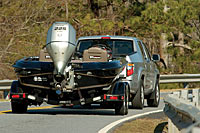
It was the club bass tournament that never was. Well, for me, at least. I had paid the early registration fee, tuned up the outboard, checked out my 20-foot bass boat, and hit the road long before daylight to make the tournament's safe-light launch at the lake near my home.
But I never made the launch ramp. A fried wheel bearing on my trailer brought the trip to a smoky stop, and I was lucky to get the rig to the side of the narrow county road without damaging my boat.
While surveying the damaged axle, I realized that although I had carefully checked the boat, outboard, and fishing tackle, I hadn't given my SUV and trailer more than a cursory once-over. However, the lesson learned from this experience was more valuable than any year-end club trophy or cash award: You can't go fishing if your tow vehicle and trailer aren't in tip-top shape.
Sure, you may be able to skate by a few times. But sooner or later, the odds will catch up, and you'll be stranded alongside the highway with a disabled vehicle or trailer. Only luck will keep the incident free of damage to the boat, tow vehicle, or injury to the occupants.
The only way to minimize potential problems is by simply planning and performing regular preventive maintenance on the tow vehicle and trailer.
Whenever performing maintenance and safety checks, start with the tow vehicle. For most of us, the tow vehicle is also our daily transportation, so it only makes sense to check it first and thoroughly. Here're the areas that need to be checked before hooking up the trailer and heading out in search of a prize-winning lunker:
See and Be Seen
Most fishing trips require a pre-dawn getaway and an after-dark return trip. Visibility is the key to a safe arrival at the launch ramp and home base. Start by cleaning the windows and mirrors. Use an ammonia-based cleaner such as Windex and newspaper to clean the glass (inside and out) to a crystal clear and streak-free finish.
Then, examine the wiper blades; they should be clean and flexible. Replace any blades that are cracked, hard or chipped. Next up, check to ensure the headlights, taillights, directionals, brake lights, and four-way flashers are all working properly. Finish up by giving the lights a good cleaning to ensure maximum illumination.
Where the Rubber Meets the Road

Over- or under-inflated tires wear out more quickly than properly inflated ones and are much more prone to catastrophic failure. They can also make a big difference in fuel economy. For maximum tire life, inflation should be checked and adjusted monthly.
The proper tire inflation levels for your tow vehicle are usually listed on the driver's doorframe or doorpost, but they may also be listed on the fuel filler door or on the inside of the glove box. Buy a quality air pressure gauge and check inflation levels while the tires are still cold (driven less than a mile), adjusting accordingly.
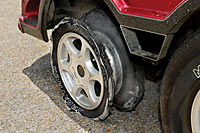
Examine the tires for abraded, bruised, or cracked sidewalls, excessive or unusual tread wear such as scalloping (indicate bad shocks), wear on one side only (alignment), center wear, or outside edges wear (improper inflation), and look for chunking tread, nails, and other problems. Replace any tires exhibiting excessive wear, and don't forget to check the spare for both wear and inflation level.
Lastly, get out the tire wrench and make sure all the lug nuts are snug.
Stop On a Dime
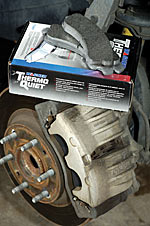
Having good brakes is essential for safety, especially when towing. Even though the trailer has its own breaking system, the tow vehicle supplies primary stopping power and, most of that, with the front brakes. Check and top up the brake fluid, then check the brake operation. The pedal should be firm, not spongy, and the brakes should smoothly engage - no grabbing.
Also, take the vehicle for a short test drive and listen for squealing or grinding when you apply the pedal. These noises indicate excessive brake pad wear and mean a brake job is needed. Pull the tires and do a physical inspection at least every couple of months. Finally, check the operation of the parking or emergency brake. There's nothing more embarrassing than having your tow vehicle, boat, and trailer drive away without you at the wheel.
Under the Hood
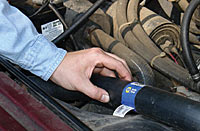
Before heading out on any trip, you should check the components under the hood. Ensure the engine oil is topped up, the battery connections are tight and clean, and vital fluids are at proper levels.
Examine the serpentine or V-belts to ensure they are in good condition; check for cracks, splits, chunking, or other signs of abnormal wear. More than one club member has been stranded alongside the road because of a broken belt.
Towing anything always puts an extra strain on the cooling system and automatic transmission. These two must be in tip-top shape if you want to avoid roadside stranding. Also, check the radiator and trans cooler fins for damage and use a soft brush and a hose to ensure the fins are free of dirt, debris, and bugs.
Squeeze the hoses with your thumb and forefinger; they should feel pliant and firm. Hoses that are spongy, soft, cracked, or too hard should be replaced immediately.
Check the coolant level, and at least once a year, replace the coolant with a premium summer coolant/antifreeze.
Drive the vehicle for about 20 minutes to bring the automatic transmission fluid up to operating temperature, and then check the dipstick for the correct level and condition. Automatic transmission fluid should be checked with the engine running, the vehicle in "Park," and the parking brake set.
Trans fluid should be translucent red. High heat levels generated by towing in overdrive (never do that!) can scorch transmission fluid, making it appear brownish and smell burnt. If this is the case, an immediate fluid/filter change is called for.
A Hitch in the Works
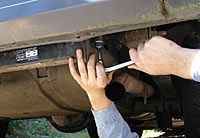
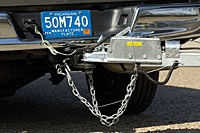
Before every tow, take a few minutes and examine the receiver hitch. Check for apparent damage from scraping or impact, make sure the receiver slide hole is clean and lubed, and inspect the mounting points of the unit.
Ensure the mounting nuts are properly torqued down, and there is no corrosion. While under the vehicle, inspect the vehicle's springs and shocks for apparent damage.
Next, inspect the hitch ball and the receiver tongue. The ball must be tight and the tongue free of burrs, rust, or other problems hindering installation. If the hitch is a bumper-mounted unit, inspect the bumper mounting points, overall bumper condition, and hitch ball tightness.
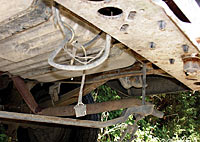
Finally, examine the wiring harness and plug that the trailer wiring plugs into. The connector plug should be corrosion-free, and the wiring should be in good condition. Repair or replace any abraded wires.
Trailer Once-Over
Even though bass boat trailers look simple, there is still much to consider. You can start by walking around the unit and looking over all the welded and bolted joints for integrity. Cracked or broken welds need fixing immediately, and bolts need to be checked for tightness. Carefully inspect the tongue, hitch ball receiver and locking mechanism, safety chains/cables, and trailer jack. Make sure they all work correctly and lube them with light industrial grease.
Then, inspect the springs, axle(s), and mounting bolts for each, tightening as needed. Check the overall tire condition and inflation pressure.
After that, it's time to check the brakes. Jack the trailer up and pull the wheel drums (rotors/discs for those with the nicer brake systems) for a thorough inspection and, simultaneously, check, clean, and repack the wheel hub bearings.
Trailer lights get much dunking at the launch ramp, and corrosion creeps into older-style light sockets and wiring. Check the entire wiring harness, from the hitch connector plug to the license plate lamp. Look for corroded plugs/sockets, abraded wiring, dangling wiring, hanging lights, and anything else that looks out of the ordinary.
If your trailer isn't equipped with sealed lights, I suggest pulling the light bulbs and spraying an anti-corrosive electrical lubricant into every socket. Then plug the harness into the tow vehicle and check to ensure taillights, license plate light, directionals, and stoplights are all working perfectly.
Finally, it is a good idea to check the condition and working order of the bow winch and cable, rollers, and bunks. These must be perfect to avoid damage to the vessel and make launch/retrieval effortless.
Inspect the winch and cable or strap. Lube as necessary and replace worn straps and cables.
Rollers usually have grease fittings and fill with a marine-grade lubricant. On the bunks, check to ensure the carpet padding is firmly attached, that it is not overly worn down and that there are no protruding staples, screws, or nails sticking through that might damage the hull.
If you take the time to perform the above maintenance routine before every club outing, you can rest assured there will seldom be a tournament missed due to a mechanical malfunction.
Reprinted with permission from



